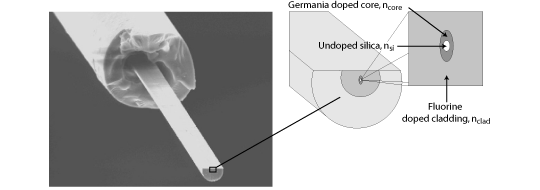Navigation Menu 
[expand all...]
[COLLAPSE ALL...]

|
Surface-Relief Fiber Bragg Gratings (SR-FBG)
Surface-relief fiber Bragg gratings have the same basic operational characteristics as
standard fiber Bragg gratings.
The main difference between these devices is in the method used to fabricate the gratings into the fiber.
The gratings of standard FBGs come from a periodic modulation of the index of refraction in the core. However,
in SR-FBGs the gratings are physically etched into the fiber. This allows SR-FBGs to operate at elevated temperatures
where the gratings in standard FBGs are erased. As a result,
surface-relief fiber Bragg gratings are ideal for sensing applications where high temperatures
would limit the operation of standard fiber Bragg gratings. Ideally, an SR-FBG will maintain functionality
as a sensor in temperatures up to the melting point of glass.
How do SR-FBGs Work?
The characterizing operation of an FBG is its ability to reflect a specified wavelength of light within its
transmission spectrum. The reflectivity of a fiber Bragg grating is dependent on the amplitude and length of the
grating as well as its percentage overlap with the field of guided modes supported by the fiber core.
Surface-relief fiber Bragg gratings are etched into the cladding above the core of D-fibers
where interaction remains within the
evanescent field
of supported modes. SR-FBGs must be fabricated within close proximity to the core
because their interaction is with only a small portion of the guided fields. The high index
modulation of SR-FBGs compared to standard FBGs helps offset reflectivity loss from small
field interaction.
 
D-fibers with elliptical cores are utilized in the fabrication of SR-FBGs because the flat side of the fiber cladding
(which trademarks its D-shape) is within close proximity to the core of the optical fiber. It is this proximity
that allows the Bragg grating to be etched in a location ideal for the reflectivity required in device operation.
The elliptical nature of the core also enhances the operation of the SR-FBG. Follow this link to
learn more about: SR-FBG fabrication. Current research
involves improving methods in the fabrication of surface-relief fiber Bragg
gratings for high reflectivity.
Surface-Relief Fiber Bragg Grating Assymetry
A unique and essential difference between the operation of FBGs and SR-FBGs is the
symmetry/assymetry of the interaction of the Bragg grating with supported modes in the fiber core.
In standard Bragg gratings, the index modulation of the core affects guided modes uniformly.
However, surface-relief fiber Bragg gratings only exist on the flat side of the D-fiber and
will affect guided modes differently. In our use of elliptical core fibers, the x-polarized
and y-polarized modes have reflection peaks at different magnitudes (depending on which mode has a
greater interaction with the Bragg grating). Furthermore, the assymetry of the effective index of
refraction between the x-polarized and y-polarized axis offers more monitoring parameters because each
axis will have a different Bragg wavelength. For example, it should be possible to detect both transverse
and longitudinal strain simultaneously with an SR-FBG. Longitudinal strain will cause the reflection peaks of the x and y axes
to shift in the same direction whereas transverse strain will cause the reflection peaks to shift apart from
each other.
Future Developments in Surface Relief Fiber Bragg Gratings
Current research involves increasing the reflectivity of the Bragg grating so that both axis
can be monitored at high reflectivity. This requirement is critical in the future use of surface-relief
fiber Bragg gratings as multi-axial strain sensors. We are looking into developing methods to create a deeper and
more uniform etch into the fiber. Also, using fiber with an elliptical core oriented at 45
degrees from its flat edge would allow greater interaction with both modes of propagating light.

|
